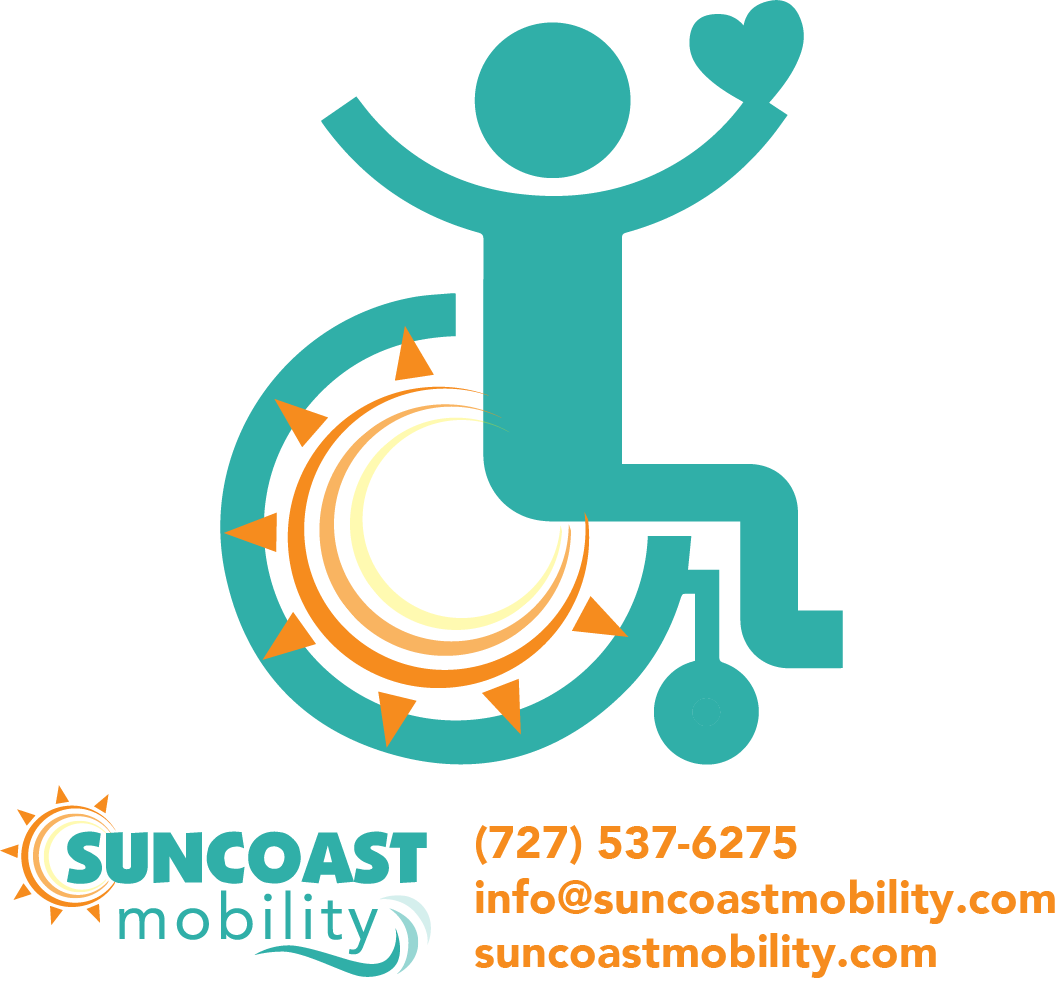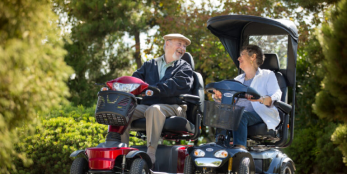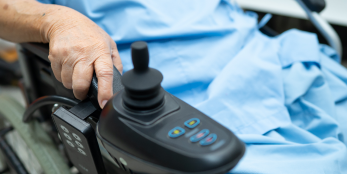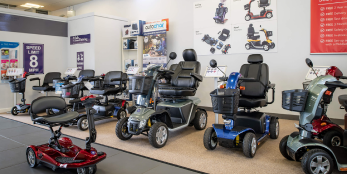Table of contents
The two most common mobility devices are power wheelchairs and mobility scooters. Both can help individuals navigate daily life with ease if walking is difficult. However, while they serve a similar purpose, they have key differences. This article will explore the distinctions between mobility scooters and power wheelchairs, and provide guidance on how to select the right option based on your specific needs.
Mobility Scooters
Mobility scooters are one of the most popular and affordable options for those who need moderate mobility assistance. These battery-powered devices are ideal for individuals who need help getting around but still have some upper body strength and dexterity to operate the scooter's tiller (steering column). Mobility scooters are great for travel; many models are foldable or disassemble into smaller, more portable pieces, which makes them easy to store in a vehicle or even take on an airplane.
Buyers have the option of choosing between three-wheel and four-wheel scooters. Three-wheel scooters tend to have a tighter turning radius, which is great for maneuvering in smaller spaces, but they are generally less stable than their four-wheel counterparts. Four-wheel scooters offer increased stability and can handle a variety of terrains, making them a better option for outdoor use.
However, mobility scooters may not be the best choice for individuals who lack arm or torso strength, or for those who need to navigate very tight spaces. These devices tend to be larger and require more space for storage and maneuvering.
Example: Golden Technologies Buzzaround CarryOn Mobility Scooter
The Buzzaround Carry-On mobility scooter is designed to provide an enhanced travel experience with its advanced features. One of its standout qualities is the infinitely adjustable tiller, allowing for personalized comfort and precision control, ensuring a tailored fit for every user. This scooter is also equipped with a comprehensive lighting package, including both front and rear lights, ensuring improved visibility and safety in various lighting conditions.
Powered by a high-performance lithium-ion battery, the Buzzaround Carry-On offers an impressive range of up to 14 miles on a single charge, making it a reliable companion for both short trips and day-long excursions. It supports an active lifestyle with a weight capacity of 300 lbs. and features a top speed of 3.6 mph.
For ease of transport and storage, the scooter folds down to just 12 inches in height (without the seat), making it perfect for stowing under beds or in car trunks. Its heaviest piece weighs only 47.5 lbs. without the seat and batteries, offering easy portability. Additionally, it includes a built-in USB port, enabling you to charge your devices on the go, adding to the convenience during your travels.
With its blend of portability, comfort, and advanced features, the Buzzaround Carry-On is an ideal mobility solution for those looking to maintain independence while traveling. Please take the time to watch our unboxing video here.


Physical Abilities Needed to Drive an Electric Mobility Scooter
-
Arm Strength
- Required Action: Mobility scooters are controlled using a tiller connected to the handlebars. The user must have sufficient upper body strength to hold their arms out for extended periods and steer the scooter with both hands.
- Considerations: Those with limited arm strength may struggle with long-term control, especially on longer rides.
-
Climbing One Step
- Required Action: To mount and dismount the mobility scooter, users often need to climb onto the platform. Most models require the ability to fold up armrests and step onto the platform to sit down.
- Considerations: Some scooters have swivel seats, which make mounting and dismounting easier, especially for people with back issues or limited flexibility.
-
Torso Control
- Required Action: Users need to be able to sit up straight and maintain balance in the seat. Lighter models may not offer extra support features like seat belts or headrests, so it's important to have good torso control.
- Considerations: If maintaining balance is difficult, a four-wheel mobility scooter may be a better option, as it offers more stability compared to three-wheel models.
Power Wheelchairs
While mobility scooters are often considered entry-level options, power wheelchairs are designed for individuals who require more significant assistance in their daily lives. These chairs are specifically for people with reduced mobility who rely on a device for regular use. Unlike manual wheelchairs, power wheelchairs are battery-powered and operated using a joystick, allowing users to control the chair with minimal effort.
Power wheelchairs have a more compact design compared to mobility scooters, making them easier to maneuver in smaller spaces, such as inside a home. However, many power wheelchairs lack the portability that mobility scooters offer, and they can be more difficult to transport. That being said, some folding or disassembling models are available for greater convenience.
Example: Golden Technologies Cricket Folding Power Wheelchair (39.3 lbs.)
The Cricket folding power wheelchair is designed with both style and functionality in mind, featuring a well-styled joystick that makes daily tasks, like driving up to a table or maneuvering through doorways, a breeze. With a 22-inch turning radius, the Cricket offers excellent maneuverability, making it perfect for indoor use and tight spaces.
The wheelchair supports a 300 lb. weight capacity, reaches a maximum speed of 3.7 mph, and has an impressive operating range of up to 9.3 miles on airline-approved 12 AH 24V lithium-ion batteries. This makes it ideal for both short trips and longer outings.
For added convenience, the Cricket offers offboard charging, so you can easily recharge your wheelchair without needing to move it. It also folds effortlessly for easy transport, allowing you to take it on the go whether you're traveling by car, plane, or public transport.
With its blend of excellent performance, portability, and style, the Cricket power wheelchair is the perfect choice for an active lifestyle, offering both practicality and independence for users on the move.


Physical Abilities Needed to Drive a Power Wheelchair
-
Ability to Perform Small Movements
- Required Action: Power wheelchairs are typically controlled via a joystick or control pad, which can be operated with one hand. The ability to make small, precise movements with the hand or fingers is crucial for controlling the wheelchair's direction.
- Considerations: If someone lacks fine motor control or the ability to use their hands effectively, power wheelchairs can often be modified. For example, some can be adapted to be controlled by small movements of the chin or tongue, making them suitable for individuals with limited hand function, such as those with muscular dystrophy.
-
Ability to Charge the Power Wheelchair
- Required Action: Like mobility scooters, power wheelchairs need to be charged regularly. Users need to be able to plug in the charging cable to the control panel and the wall outlet.
- Considerations: If a user lacks the fine motor skills or strength to plug the wheelchair into the charger, they may need assistance from a caregiver, family member, or a helper.
Key Differences in Physical Requirements:
-
Mobility Scooters: These are more physically demanding when it comes to mounting and dismounting. Arm strength is required for steering, and torso control is necessary for maintaining balance. Those with limited balance or difficulties with stepping onto the scooter may find them challenging.
-
Power Wheelchairs: These require the ability to control a joystick or pad with one hand, or in some cases, with specialized controls (chin or tongue). For those with severe upper body weakness or limited fine motor skills, a power wheelchair offers the customizability to meet individual needs. However, users must still be able to charge the device, and this might require assistance if the individual can't manage the charging process.
Questions to Ask Before Buying
Before deciding whether a power wheelchair or mobility scooter is the right choice for you, consider these important questions:
- What is the level of mobility of the person who needs the device?
- How often will the mobility scooter or power wheelchair be used—daily or just occasionally?
- Does the user have sufficient arm and torso strength to operate a scooter's tiller (steering column)?
- Will the user be traveling frequently?
- How critical is portability in relation to the user’s lifestyle?
- Where will the device primarily be used (indoors, outdoors, or both)?
Are Electric Wheelchairs Better Than Mobility Scooters?
The answer to this question depends entirely on your individual needs and preferences. Mobility scooters are ideal for individuals who have some upper body strength and can operate the steering column. They are also better for those who will use the device for shorter periods and may require occasional transport. On the other hand, power wheelchairs are better suited for individuals with limited mobility who will rely on the device every day. Both devices have pros and cons, so the decision ultimately comes down to which device best fits the user’s daily routine.
The choice between a mobility scooter and a power wheelchair largely depends on the user's physical abilities and the level of independence they seek. Mobility scooters are ideal for individuals who have sufficient upper body strength, balance, and can climb steps. Power wheelchairs, on the other hand, provide more customization for those with limited hand strength or mobility challenges, offering more accessibility features like joystick modifications or alternative control methods. Both devices can greatly improve mobility, but understanding the physical requirements can help ensure the right choice is made.
FAQs
When should I choose a mobility scooter?
You can independently transfer onto a scooter, but you require assistance with walking long distances outdoors. You have good upper body strength and coordination to operate a tiller.
When should I choose a power wheelchair?
You have mobility challenges that impact your ability to walk or transfer, and you often need to navigate tight indoor spaces. Additionally, you may have limited hand dexterity or upper body strength.
What key factors should I consider when choosing between a mobility scooter and a power wheelchair?
- Consult a healthcare professional : Speak with a doctor or therapist to choose the right mobility device for your needs.
- Try before you buy : Test various models in-store to evaluate comfort and maneuverability.
- Consider insurance coverage : Verify with your insurance provider if mobility aids are covered.
Which is more suitable, a power chair or a mobility scooter?
Electric wheelchairs are designed for outdoor use but are best suited for flat, smooth surfaces and gentle slopes, like access ramps. For more challenging terrain and steeper hills, a mobility scooter provides the necessary power and stability.
What are the disadvantages of mobility scooters?
Mobility scooters provide many advantages, particularly for individuals with limited mobility, but there are also some drawbacks to consider:
Limited Terrain Capability : Mobility scooters typically perform best on smooth, paved surfaces and may struggle on rough or uneven terrain, or in areas with steep inclines.
Battery Life : The range of a mobility scooter is dependent on the battery's charge. For extended outings, you may need to recharge or carry extra batteries, especially for longer trips.
Storage and Transport : Many mobility scooters are bulky and can be challenging to transport in a car or store in small spaces. Although some models are foldable, they can still be cumbersome in tight areas.
Speed : Mobility scooters are relatively slow, with a maximum speed of around 4-8 mph. This can feel slow for some users, particularly when trying to keep up with others or cover longer distances quickly.
Limited Indoor Use : Due to their size, many mobility scooters aren’t well-suited for indoor use. They might not fit through doorways or in elevators, and they could be too large for smaller spaces.
Safety Concerns : Operating a mobility scooter can present safety risks, particularly for those who are unfamiliar with them. Sharp turns, high speeds, or lack of adequate lighting and reflectors for nighttime use can cause instability or accidents.
Maintenance Costs : Regular upkeep, such as battery replacements and tire maintenance, can become expensive over time. Frequent repairs can add up, creating a financial burden.
Weight : Some mobility scooters are heavy, making it difficult for people with limited strength to lift, store, or move them.
Social Stigma : Using a mobility scooter may cause some individuals to feel self-conscious or encounter negative perceptions, as some people associate scooters with disability, which can affect the user’s confidence.
While these drawbacks do not outweigh the benefits for many users, they are important considerations when selecting a mobility aid.
What are the disadvantages of power wheelchairs??
Power wheelchairs provide significant convenience and independence for individuals with mobility challenges, but they do come with some drawbacks:
-
Cost : Power wheelchairs can be quite expensive, ranging from a few thousand to tens of thousands of dollars, depending on the features and customization needed. While insurance may cover part of the cost, not everyone can afford the full price.
-
Size and Weight : Power wheelchairs are generally larger and heavier than manual wheelchairs, making them difficult to transport. They often require a vehicle with a lift or ramp for loading and unloading, which may not be feasible for everyone.
-
Maintenance : Regular upkeep is necessary to ensure the motors, batteries, and electronic parts function properly. Repairs or replacements can be costly and may require specialized services or knowledge.
-
Battery Life : The batteries in power wheelchairs need frequent charging, and their range can be limited. Users must plan to ensure the battery lasts throughout the day, and over time, the battery's performance may decline, necessitating replacements.
-
Terrain Limitations : While some power wheelchairs are built for outdoor use, many models struggle on uneven surfaces like gravel, grass, or bumpy sidewalks. They are generally more suitable for smooth indoor environments.
-
Complexity : Power wheelchairs are more complex than manual ones, making them harder to operate for those unfamiliar with the technology or those with cognitive impairments. The controls may also be difficult for individuals with limited hand dexterity.
-
Storage : Due to their size, power wheelchairs can be hard to store in small living spaces, and finding suitable storage solutions can be a challenge for some users.
-
Weather Vulnerability : Exposure to rain or snow can damage the electrical components of a power wheelchair, meaning users may need to take precautions or avoid going outside in wet weather conditions.
These disadvantages can play an important role in the decision-making process for individuals considering whether a power wheelchair is the right mobility solution for their needs.
In Conclusion
This article compares two common mobility devices: mobility scooters and power wheelchairs. Both help individuals with mobility challenges, but they differ in design, features, and physical requirements.
Mobility Scooters:
- Best for those with some upper body strength and dexterity.
- Controlled via a tiller (steering column) and available in three-wheel and four-wheel models.
- Three-wheel models are more maneuverable in tight spaces, while four-wheel models are more stable and better for outdoor use.
- Ideal for travel, as many models are foldable or can be disassembled.
- Not suitable for individuals with limited arm or torso strength or those needing to navigate tight spaces.
Power Wheelchairs:
- Designed for individuals who need more assistance in daily life and typically require a device for regular use.
- Controlled by a joystick, offering easy maneuverability in smaller spaces.
- More compact than mobility scooters but less portable.
- Better for individuals with limited arm or torso strength, as some models can be adapted for users with minimal hand control.
Physical Requirements:
- Mobility Scooters: Requires arm strength, torso control, and the ability to mount and dismount.
- Power Wheelchairs: Requires the ability to perform small movements with a joystick, with options for customized controls for those with limited motor skills.
Key Differences:
- Mobility scooters are physically demanding for mounting and require more upper body strength, while power wheelchairs are more adaptable to users with severe mobility issues.
- The choice between the two depends on the user's mobility level, lifestyle, and specific needs.
Decision Factors:
- Consider the user's level of mobility, the frequency of use, the need for portability, and where the device will be used (indoor vs. outdoor).
Ultimately, the right device depends on individual needs—mobility scooters are better for those who need occasional assistance, while power wheelchairs are suited for those with more significant, ongoing mobility challenges.
If you’re still unsure which device is right for you, our team of mobility experts is here to help. Feel free to contact us by phone at 727-537-6275 or email for personalized assistance and to inquire about special pricing options that are being offered.








